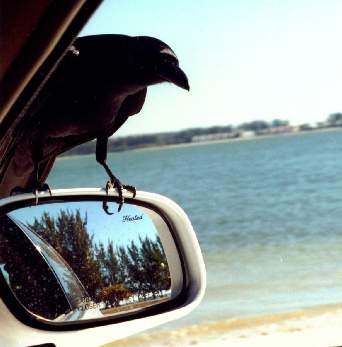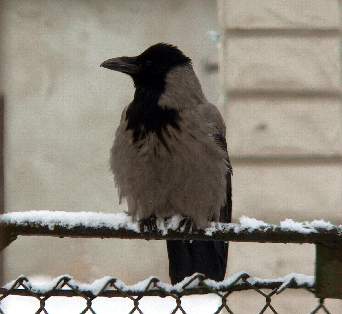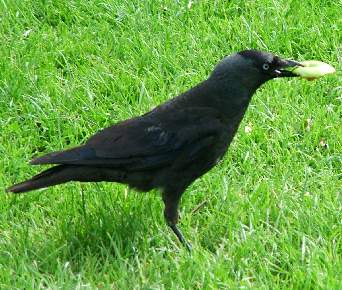
What's behind us? Picture of a Crow on a heated car wing mirror.

Photo of Hooded Crow (Corvus Cornix) in the Winter Snow.

"This will be nice for lunch". Picture of Crow having found some tasty food.
|
The name Crow is in nearly all european
languages a name which graphically mimics the typical cries of these birds.
For example, the modern german name is word is "Krähe". In Holland
the Crow is "Kraai", and in French it is "Corbeau".
The Corvidae family is sometimes referred to as
the crow family, but the true Crows are birds of the Corvus genus which
is just one particular genus within the Corvidae family. Within this
genus there are around 42 species.The larger representatives of the corvus genus
are the Ravens, the smaller ones are Crows, and among the very smallest
are the Jackdaws. The Rook is also a member of the corvus genus and
can be distinguished from the Crows and other fellow members of this genus
by the existence of an area of bare grey-white skin around the base of
the bill of the adult Rook, in front of the bird's eyes. In
addition the feathers around the Rook's legs appear a little more ruffled
than those of the Crow.
The crows have a large geographic distribution.
All the temperate zones of all continents (with the strange exception of
South America) and many oceanic islands including Hawaii have representatives
of members of the Corvus genus. The crows seem to have evolved in
central Asia and soon to have extended their territory to North America
(including Mexico), Africa, Europe and Australia.
The beak of the crow is thick and strong, the top
being slightly downwardly curved and with a narrow point. The wings
are quite long, with narrow, pointed feathers.
Some species form large colonies with a complex
social structure. Usually they form monogamous couples.
The nest is built in high treetops or in hollow
trees. All species of Crow build simple and uncomplicated nests which are
quite shallow, made of sticks and twigs, intermixed with mud. A ball
made of a variety of soft matter is included in the nest for padding.
Usually between three and seven eggs are laid. Once hatched, male
and female crows are equal in appearance. After their first year
the young birds attain their full adult plumage.
Crows are very resourceful creatures. 19th Century ornithologist, A. Newton wrote of how in "British India", in any lengthened
camp settlement or station that was established, House Crows (Corvus splendens) would build their nests from the wire from the Englishman's soda-water bottles, and that these crows were so used to humans that the crows would dispute for meat from the fires with both Kites and cooks.
Crows are actually omnivorous and their natural food includes small invertebrates, fruits and seeds. The Fish-Crow (Corvus ossifragus) of the USA, deserves spcial mention as it has a particularity toward shrimps and fish as well as crabs and other crustaceans, although will also eat other food like fruit, grains, peanuts and small reptiles, and even small nestlings belonging to other types of bird. Other crow species may sometimes also feed on fish which have been thrown ashore by the sea although these others will rarely draw fish from the waters themselves.
In flight the Crow is steady and straight. On the ground these birds tend to hop rather than run, which gives them a rather amusing bouncy appearance.
|





